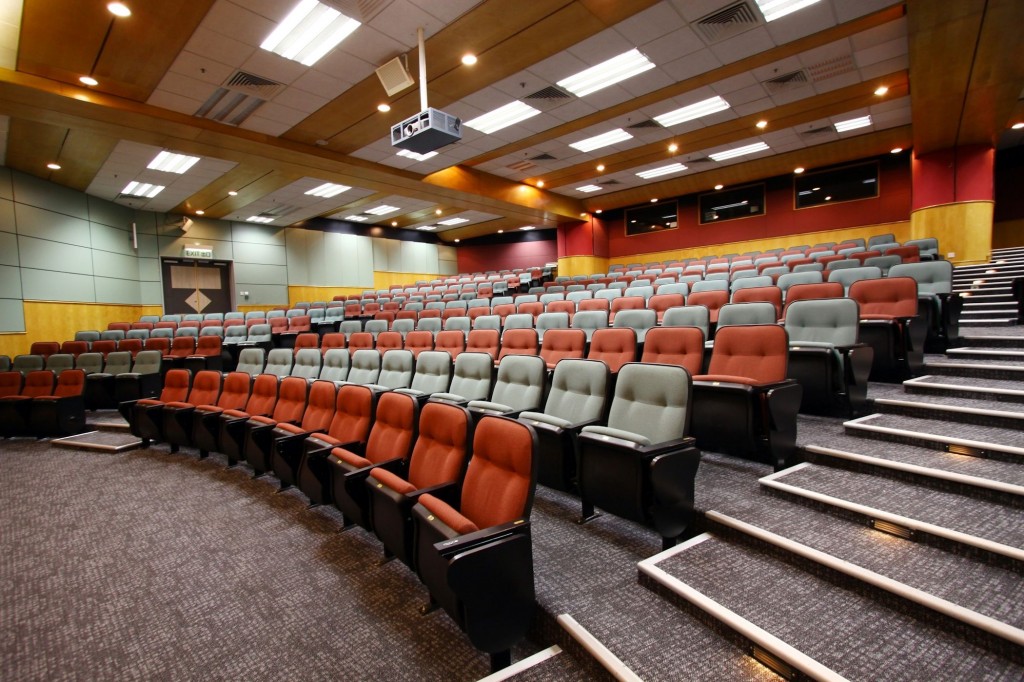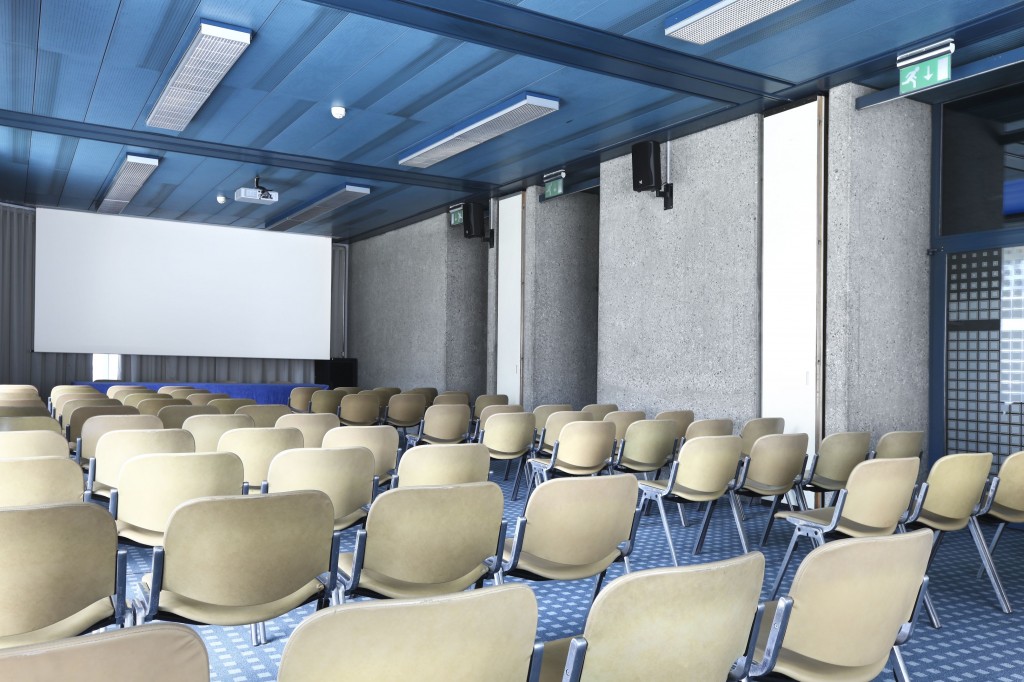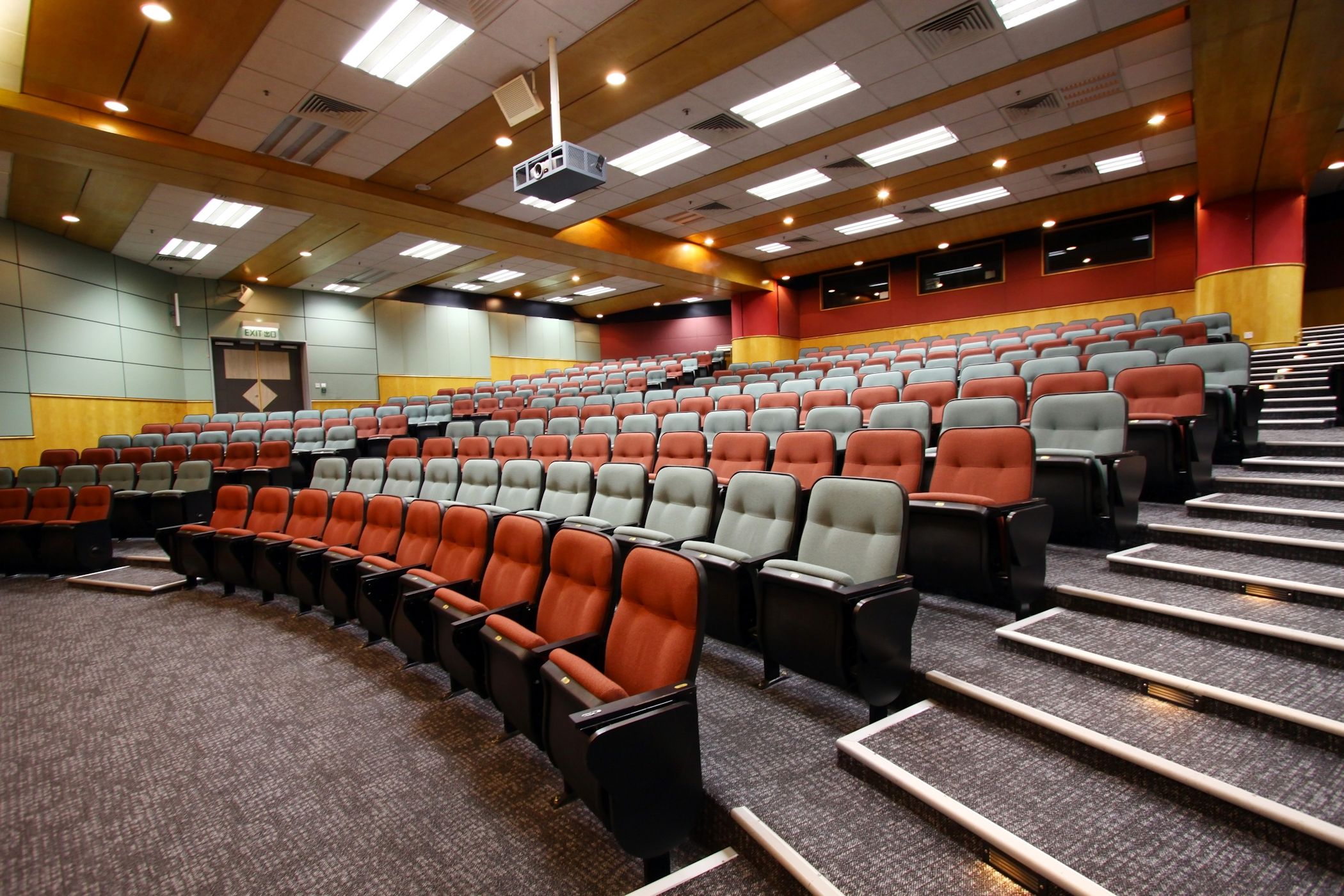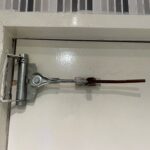This post was published in Doors & Hardware

For Assembly occupancies with fixed seating, the quantity of seats is added to the occupant load of any additional occupiable spaces to determine the total occupant load.
Many code requirements are dependent upon the occupant load of the room or space in question. For example, the International Building Code (IBC) requires panic hardware for doors equipped with a lock or latch, which serve assembly or educational occupancies with an occupant load of 50 or more (the occupant load limit for NFPA 101 – The Life Safety Code is 100 or more).
In order to apply the code requirements correctly, it is sometimes necessary to calculate the occupant load of a room or space. The IBC defines Occupant Load as: “The number of persons for which the means of egress of a building or portion thereof is designed,” and NFPA 101 defines it as: “The total number of persons that might occupy a building or portion thereof at any one time.”
To calculate the occupant load, the first step is to calculate the area of the space in question by multiplying the length times the width – typically measured within the interior faces of the walls. For example, if a classroom measures 30 feet by 40 feet, the nominal area is 1,200 square feet (30’ x 40’ = 1200 SF).

When an Assembly occupancy includes tables and chairs, it is typically considered a less concentrated or unconcentrated use, with an occupant load factor of 15 net square feet per person.
The next step is to divide the area by the occupant load factor, which varies depending on the use of the space. This factor establishes the amount of square footage per occupant; a warehouse would have a lower occupant load and more square footage per occupant, while a nightclub would have a much more dense occupant load and less square footage per person.
In the IBC, the occupant load factor is found in a table called Maximum Floor Area Allowances per Occupant (Table 1004.5 in the 2018 and 2021 editions). In the 2012-2021 editions of NFPA 101, it is Table 7.3.1.2 – Occupant Load Factor. The factors vary depending on which code is being used, so you must consult the code in effect for the project location. The factors included in these tables are indicative of typical occupant densities for each use.
For classrooms, both the IBC and NFPA 101 list an occupant load factor of 20 net square feet per person. Factors are based on either gross or net floor area.
- Gross floor area is measured within the inside surface of the walls, and includes all occupiable and nonoccupiable spaces. Bathrooms, closets, electrical/mechanical rooms, and other nonoccupiable spaces are not subtracted from the gross floor area.
- When an occupant load factor is based on the net floor area, the calculation is based on the actual occupied area. Nonoccupiable spaces like corridors, stairs, bathrooms, electrical/mechanical rooms, closets, and fixed equipment are subtracted from the total area to determine the net floor area.

Concentrated use in an Assembly occupancy may include chairs that are not fixed, and the occupant load factor is 7 net square feet per person.
To calculate the net floor area of the classroom used in our example, you would take the gross area (1200 square feet) and subtract any nonoccupiable space. For example, let’s subtract 80 square feet for a classroom storage closet, leaving us with a net floor area of 1,120 square feet. We would then divide the net area (1,120 square feet) by the occupant load factor from the table (classrooms = 20 net square feet per person), to calculate an occupant load of 56 occupants. If the prevailing code was a recent edition of the IBC, this load would trigger the requirement for panic hardware (as well as two exits and outswinging doors). If NFPA 101 was used, panic hardware would not be required for this occupant load.
For assembly occupancies with fixed seating, the seats are counted to determine the occupant load. Seating for benches without dividing arms (for example, bleachers) is calculated at 18 linear inches of seating length per person. Additional occupiable space (for example, a waiting area) is calculated using the occupant load factor for that space, which is then added to the number of fixed seats.
Several additional occupant load factors are listed for assembly occupancies without fixed seating. Unconcentrated or less concentrated use (15 net square feet per person) may have tables and chairs, concentrated use may be set up with chairs only (7 net square feet per person), and standing space is addressed by the IBC with an occupant load factor of 5 net square feet per person.

According to the International Building Code (IBC) standing space is calculated using an occupant load factor of 5 net square feet per person.
Once you are able to calculate the occupant load, you can determine the applicable code requirements for doors serving that space, including how many egress doors are needed, and whether they are required to swing in the direction of egress. This calculation and the posted occupant load limit required for some occupancy types will also help to prevent unsafe occupant loads if properly enforced. The Authority Having Jurisdiction (AHJ) should be consulted for any questions regarding occupant load.
You need to login or register to bookmark/favorite this content.








Wow, this is a tremendously helpful article, I wish it had been written about five years ago when I needed it!
Thanks! Let me know what else you need and I’ll try to be more timely! 😀
hi can you tell me how to calculate the occupant load of an office suit with an area of 2800 sft?plz
Hi Aamir –
I can’t say for sure since I have not seen the layout and I don’t know which code you’re supposed to be using, but the occupant load factor for “business areas” from the 2018 IBC is 150 gross square feet per person. With an area of 2800 square feet / 150 square feet per person, that works out to an occupant load of 19 people.
– Lori
Hello
I am trying to figure out occupancy for a karate dojo that is about 2500 square feet. Thanks
Hi Erik –
I think a karate dojo would usually be considered an assembly occupancy using the unconcentrated use factor of 15 SF per person. That would result in an occupant load of 167 people.
– Lori
Thanks! I was discussing net vs. gross and also assembly with a potential client. It’s much easier to point them here than to dig out the IBC and wade through it.
I’m glad it was helpful!
I read every readily comprehensible word, and I still have not a tiny clue why all the many persons associated are allowing s e v e n Oxacans to live in the one bed. Apt. Next to my one bed. Apt.Crap! They’re mean!
Hi…anybody can help me to culculate human load for stage 24ft x 18ft. How many person can be on stage in 1 time. We use a-frame scaffolding and wooden platform. Thanks
Hi Faizal –
For a stage, the IBC and IFC use an occupant load factor of 15 net square feet per person. If the entire area of your stage is occupiable, the area is 432 square feet (24 x 18) – then divide by 15 net square feet per person to get an occupant load of 29 people.
– Lori
Thanks lori…really help me. Thanks
Can i know what is IBC and IFC? also i want to know what is 15net? Thanks
The IBC is the International Building Code and the IFC is the International Fire Code. I don’t know which codes are used in your area, but these are widely-used so they will at least give you an idea of the occupant load. Each type of occupancy has a certain occupant load factor, as I mentioned in the article, and the occupant load factor for stages is 15 net square feet per person.
– Lori
Ok understand…thanks
Great article thanks. My county uses the 2006 IBC. According to section two, the business I am opening is classified as amusement, so an A-3 assembly. However, it says if the occupant load is <50, then consider yourself a Business (zoned B). I have a 3000 sf space, but we never expect to have more than 50 people. Can we just impose our own maximum occupancy maximum of 49 people to be considered a business, or do we have to do (3000 sf. – nonoccupiable)/5 sf. pp. for standing space = ~2500/5 = 500 people, which would make us not only an A-3 but also subject to many more codes?
Hi Mike –
Sorry for the delay – I’ve been traveling and my inbox got out of control. The final answer to your question will be up to the local code official, but I have not seen AHJs allow this very often – especially for new occupancies. They might let you use the unconcentrated use factor of 15 which would still put you over the 49-person limit, but would reduce the number of required exits.
– Lori
I have an 10000 sq ft building, with three exits, front, back and one side.
How does one calculate the increased occupancy load? I am trying to calculate for a retail space which is 100% covered by an Automatic sprinkler system, and I’ve heard that this should allow for increased occupancy, but I cannot find any information saying this in IBC.
Have you heard of this?
Thanks!!!
Hi Edward –
I found this in the 2015 IBC:
1004.2 Increased occupant load. The occupant load permitted in any building, or portion thereof, is permitted to be increased from that number established for the occupancies in Table 1004.1.2, provided that all other requirements of the code are met based on such modified number and the occupant load does not exceed one occupant per 7 square feet (0.65 m2) of occupiable floor space. Where required by the building official, an approved aisle, seating or fixed equipment diagram substantiating any increase in occupant load shall be submitted. Where required by the building official, such diagram shall be posted.
Here’s what the Commentary says:
An increased occupant load is permitted above that developed by using Table 1004.1.2, for example, by utilizing the actual occupant load. However, if the occupant load exceeds that which is determined in accordance with Section 1004.1.2, the building official has the authority to require aisle, seating and equipment diagrams to confirm that all occupants have access to an exit, the exits provide sufficient capacity for all occupants and compliance with this section is attained. The maximum area of 7 square feet (0.65 m2) per occupant should allow for sufficient occupant movement in actual fire situations. This is not a conflict with the standing space provisions of 5 square feet (0.46 m2) net in accordance with Table 1004.1.2. Standing space is typically limited to a portion of a larger area, such as the area immediately in front of the bar or the waiting area in a restaurant, while the rest of the dining area would use 15 square feet (1.4 m2) net per occupant.
– Lori
Hi Lori, this is a really wonderful article. I was wondering when do we use the gross floor area for calculation and when do we use the net floor area? Also, if my project is in San Francisco, where can I see if they follow CBC or NFPA?
Hi Josie –
In NFPA 101, the table referenced in the article shows some factors as “net”…for those you’d use the net area. For the other factors you would use the gross area – At the bottom of the table there is a footnote: All factors are expressed in gross area unless marked ‘net.’
In the IBC table, either gross or net is listed for each occupant load factor.
– Lori
Sorry – I forgot to answer your other question. I found the list of San Francisco codes here: http://sfdbi.org/codes. There’s also a link to the San Francisco fire code on the SF-Fire page: http://sf-fire.org/division-fire-prevention-and-investigation.
– Lori
Hi Lori,
Was wondering if you could help me occupancy load for a 4000sqf nightclub. Bar&drink rail 183 sq.ft. Booths 167sqft. Tables 1814sqft , pool table 76sqft and Isle space 90sqft.
I used 7sqft for bar and 7sqft for booths and tables I used 15sqft And pool table I used 5sqft and for Isle space I used 5sqft. I’m not sure if I’m using the correct square footage per person for the Tables and pool table. Can u help? Thanks
Hi Chuck –
If you can send me a floor plan I will take a look. lori.greene@allegion.com
The load of the booths can be calculated using 18″ of seat per person. The area of the pool table can be subtracted from the gross area to find the net area. The 5-SF factor is usually used for the dance floor or an area that will be really congested.
– Lori
I have a question about calculating occupant load in regard to bathroom requirements. When calculating either gross on a new, unfinished space, do you include the space taken by planned walls or do you simply use interior dimensions of the empty shell?
Hi Jason –
I believe the measurements are taken inside of the walls. Some occupant load calculations use a “net” figure, in which case you can subtract other uninhabitable areas like closets and fixed furniture.
– Lori
In a business setting it lists the occupancy load at 100 sqft/person. I have a room full of 8’x8′ cubicles that equate to 64 sqft/person. How can I determine how many cubicles I can fit in an open floor plan?
Hi Gilbert –
This isn’t really my area of expertise, but if you take the area of the room and divide by 100 square feet per person, that’s the amount of people the room needs to have egress for, and I would not put in more cubicles than can accommodate that number of people. There are other considerations like width of circulation spaces, length of dead ends, and travel distance to the exits.
– Lori
I ran into an occupancy issue and I think maybe you could help.
There has been a request to add some seating to a room in an art center but I need to figure out if code will permit more seating to be added. Essentially I am trying to find out how much square footage is required per seat. I have researched under the NFPA and IBC codes, but they both only list number of occupants/square foot as “use number of fixed seats”. The room is classified a Group-B Assembly. Where do you think I could look to find the amount of fixed seats allowed per square foot?
Thanks
Hi Clay –
I don’t know of a required amount of square footage per seat. If you have an open art center and want to add fixed seating to a portion of it, I would add the number of seats to the calculated occupant load of the rest of the space, and then make sure you have enough doors to accommodate that occupant load.
– Lori
Hi Lori,
This article has really helped me a lot.
I am from india We use NBC here,
in occupant load table it states that area should be 10m2 for an business occupany , can u tell me why 10m2 is used ??
I’m not familiar with the NBC, but the area of 10 square meters is consistent with the International Building Code which uses the occupant load factor of 100 square feet per person for business areas. When you divide the area of the space by this factor, you will find the occupant load of the space.
– Lori
Hi Lori,
Is occupant load related to minimum area sq ft? If you know how many persons is going to use the room then you can compute the area of the room. Is that correct?
And how about guests in an office? Are they considered or not?
The occupant load is based on the area of the room and an occupant load factor. For business areas, the occupant load factor shown in the IBC is 100 gross square feet per person. For an individual office that is 10′ x 10′, the occupant load is 1 person.
– Lori
Regarding the gross vs. net topic for concentrated/unconcentrated in assembly spaces. If I have a dining arrangement with tables and chairs, do I need to deduct the square footage of the dining tables to determine the net available square footage or would I just deduct any staging and other things (not the dining table/chairs) to determine the net available square footage?
Hi Kevin –
You don’t have to deduct the square footage of the tables. The tables and chairs are already taken into consideration because the occupant load factor for an assembly space with tables and chairs is 15 square feet per person and an assembly space without tables and chairs is 7 square feet per person. The space will be calculated to have a higher occupant load without the tables and chairs.
– Lori
Understood. Would things like portable stages, static displays etc. need to be deducted from the available square footage?
Not usually, if they are temporary items that may be there when the room is set up a certain way, but may not be there when setting up for a different event.
– Lori
Hi Lori I have an office space and I’m trying to get 9 people in. It will have desks and chairs for each person. The space is 11.6′ x 18.08′. also I’m in Washington state and haven’t had much luck finding what codes we use here.
Thanks
Hi Jeremiah –
Are you trying to determine whether you can put that many people in the office space? According to the 2015 International Building Code, the occupant load factor for a business occupancy is 100 square feet per person so the calculated occupant load of that space is far less than 9. But that calculation is not meant to tell you how many people you’re allowed to have – the calculation is used as a design factor for calculating the required size of doors, the number of plumbing fixtures, etc. There may be some other regulations that would impact how much space you have to allow per occupant.
The current codes for Washington are listed here: https://fortress.wa.gov/es/apps/sbcc/page.aspx?nid=4, but I don’t think you will find your answer there. Putting 9 people in a room of that size seems like it would fall under some other jurisdiction rather than the building code.
– Lori
Hi I’m trying to find out the max occupation for my church the square footage is 2,506 square foot and we only have 3 exits. If someone can help me out much thanks in advance.
Hi Erica –
The occupant load depends on how the room is set up. If there are fixed seats, you count the seats. For assembly spaces without fixed seating, 7 square feet per person is the factor for concentrated use (per the IBC), which would put you at 358 people. If your 3 exits comply with the requirements for clear width, remoteness from each other, panic hardware, etc., 3 exits would be sufficient for that occupant load.
– Lori
Hi! I would appreciate your help. We are trying to determine how many occupants we could have in a retail space that has a total square footage of 1365 for a kids after school computer learning center. Would we be considered a B or E classification? With a B classification, we calculate the occupant load at 14. Is that the max number of people we could have in the space? The space only has a single exit at the front. Will that suffice? Would 1 restroom meet code in this case because of the occupant load under 15? is the occupant load the max number of people that can be in the space or can we have more. We’d like to be able to have 20-30 people in the space at one time. Thanks for any guidance!
How to calculate number of exit with help of occupant load and clear width? would any body give the example for the same
Hi Manoj –
If you are following the IBC, the minimum number of exits per story is:
1-500 occupants – 2 exits
501-1,000 occupants – 3 exits
More than 1,000 exits – 4 exits
In some cases, 1 exit is allowed. There are other requirements that apply to exits such as the maximum travel distance, minimum remoteness, maximum common path of travel, calculated egress width, etc.
– Lori
I am trying to figure out the required number of fixtures. Say a building calculated as having an occupant load of 250. A different number of fixtures for males or females. Do I figure 50% males and 50% females? I have seen places where the actual percentage was quite lopsided in one way or the other. Should I add some extra fixtures to try to account for this?
Hi Khadijah –
I’m sorry – I don’t have any experience calculating fixtures.
– Lori
TABLE 403.1 talks about plumbing fixtures..
Hi, I am trying to calculate the space for a exercise room, in an area that uses IBC. 100×50 sq feet but we have large permanent structures that prevent a LOT of square footage being used.
Exercise rooms are supposed to be 50 Gross, however Assembly is listed as 15 net. Since we have approximately 1500 sq ft of storage and 2500 of fixed equipment, and 500 feet of office, would our occupancy load be 100 (50 sq ft gross) or 50 (off 750 net sq footage due to equipment and storage space)?
Hi Erik –
I would recommend checking with the building inspector on this one.
– Lori
When calculating the net area of a classroom with built in casework along the rooms perimeter, should the casework be excluded in order to obtain the net sf?
I believe so – yes. The IBC’s occupant load factor for classrooms is a net factor (20 SF net per person), so fixed components should be deducted from the square footage.
– Lori
Hi Lori,
I am trying to figure out maximum occupancy for a 1,000 sq ft brewery tasting room. Equipment and counter space takes up about 180 sq ft(820 sq ft net). We have 10 movable chairs and a picnic table for seating. Our building does have fire sprinklers. There is just one 36″ wide exit door and also a 12′ wide roll up door which will not always be open. Do you have a formula you can share for our maximum occupant load?
Hi Patrick –
The formula is the area (gross or net, depending on the occupancy) divided by the occupant load factor = the occupant load. The missing variable is the occupant load factor – these are listed in Chapter 10 of the International Building Code.
Considering the size of the room and how much space is taken up by the equipment and counter space, I can’t imagine anyone would consider this an assembly occupancy (which would mean a higher occupant load). I’m obviously not the Authority Having Jurisdiction (AHJ), but I would call it a business occupancy, which has an occupant load factor of 150 gross square feet per person.
Because it’s a “gross” factor (not a “net” factor), you use the whole square footage without subtracting for the equipment. Your AHJ might look at it differently, but it doesn’t matter that much – read on.
If the gross area of the tasting room is 1,000 square feet, and you divide that by 150 square feet per person, you get an occupant load of 7 people. According to the IBC, if this is a business occupancy and the room is on the 1st floor, you don’t need a second exit unless the occupant load exceeds 49 people or the common path of travel exceeds 75 feet. If it’s on the 2nd floor, the occupant load limit is 49. Above the 2nd floor you would need a 2nd exit. So as long as you don’t have another area exiting through the tasting room, the common path of travel is not more than 75 feet, and your one door is code-compliant, you should be ok.
– Lori
P.S. Remember I am not the AHJ…this is just my opinion/interpretation.
Lori this is excellent information. I wish it had been so easily available TWENTY FIVE years ago, when I began my stint as the district Safety Officer for a large public high school! I had to find things out by wading through IBC, NFPA and NJ DCA documents, and by dealing with state and local officials who were CLUELESS! Can you tell me how I find out if I’m required to post the total occupancy load for a 24/7 veterinary hospital? My facility doesn’t have this information posted, but I did see it posted at a similar hospital yesterday morning, and I want to be as “in compliance” as I can.
Thank you.
GM
Hi Greg –
This is a great question (time for a blog post about it)! The IBC says this:
1004.3 Posting of occupant load. Every room or space that is an assembly occupancy shall have the occupant load of the room or space posted in a conspicuous place, near the main exit or exit access doorway from the room or space. Posted signs shall be of an approved legible permanent design and shall be maintained by the owner or the owner’s authorized agent.
This is a little outside of my area of expertise, but I checked the IBC Commentary and it clearly states that this only applies to assembly occupancies, which you probably don’t have in your animal hospital. BUT – there could be a local requirement that I don’t know about, or the local code official may have had a reason for requiring the other facility to post the occupant load.
I hope this helps!
– Lori
Our auditorium is rated at a 250 non fixed chair occupancy load. The NS fire code states anything over 200 has to have the chairs tethered together.
We only have 195 chairs and never had more that that at a time. But the code says even though it may be a 50 seat function, we still have to tether the seats.
Can we make our occupancy load 199 and rental policy stating that we will not rent to functions over the 199 so we can avoid tethering 20-30 seat functions?
Hi Darren –
Great question. That’s something you need to take up with your local code official – probably the fire marshal. In some cases, the AHJ does allow the posted occupant load to be different from the calculated occupant load, but the potential problem is that people don’t always stick to the posted occupant load. I would just explain the situation to them and find out what the procedure would be to request their approval.
– Lori
how do you round fractional numbers of occupants? always round up or round up at .5 and round down if less?
Good question! I didn’t see anything in the IBC but I found this old discussion: https://www.iccsafe.org/forum/non-structural-intl-bldg-residl-codes/round-occupancy-calculations-up-or-down/. If I calculated the occupant load of a room at 49.2 people, I would round up to 50 even though it would require a second exit and possibly panic hardware. Given the possibility that an AHJ might round up rather than down, using the higher number would help avoid problems in the field.
– Lori
Hi Lori,
I’m re-purposing an antique barn in southern NH for use as an event venue (wedding receptions, etc.). Egresses have been updated and the building design reviewed to ensure we comply with LS and IBC. Using the net square footage, our local fire dept has determined the max occupancy to be 140 people based upon the 15 sq ft/person LS code requirement with tables and chairs. Where it gets interesting is that we added a 3000 sq. ft deck off of the side of the barn at the same elevation as the main floor of the barn and event area. The deck is one story off of the surrounding ground level and has its own approved egresses to the ground level. When we asked the fire dept what the occupancy could be if we combined the deck area, they stated it was still only 140. Their reason is that should there be inclement weather, occupants of the deck could try to get indoors and thus exceed the approve occupancy of the barn, (140). Therefore no additional occupancy would be permitted even with the large additional area provided by the deck. Our engineers disagree and feel the two areas should be evaluated seperately and occupancy for the two areas combined. What is your take?
Hi Hank –
My question is whether the fire department is saying that’s the maximum amount of people you could have in the barn + deck, or if that’s the number of occupants that you need to design for with regard to exits, etc. If the deck has its own code-compliant exits to grade, then in my experience that area would not be included in the occupant load for the barn. This means that the doors from the deck to the barn would not have to be egress doors for the deck, and the main entrance/exit doors for the barn would not have to accommodate the occupant load of the deck. But I have not heard of the “it might be raining” method of calculating the occupant load. Also – you could have more occupants in the barn if you use the concentrated occupant load factor, and as long as you have enough egress width, plumbing fixtures, etc., I don’t think the intent of the calculation is to say that you can only have 140 occupants total.
I can ask this question on the building code forum and see if some AHJs will weigh in if you’d like.
– Lori
I have always struggled with Narthex areas in churches. Their primary function is largely circulation and often are surrounded by doors and directions to walk. There are obvious places that people might stand and wait. I tend to draw what I call “invisible corridors” and then calculate the left over space as 5 sf per person. Does the code address this type of area? Are we supposed to be counting the entire area wall to wall in the calculation instead of removing the invisible corridors?
Thanks!
Hello!
I own a salon &spa in Ohio, we are a total of 6,000sq feet (includes 4 employee only areas) we have 8 10×10 treatment rooms, 12 styling stations, 4 pedicure thrones, and 4 nail desk stations, and 6 shampoo bowls. How do you determine occupancy for a space like this?
Hello, I own a new metal building 70×100 7000 sq ft. I was trying to open up a venue (party place) but fire Marshall requires me to install fire sprinkler system. It has a kitchen but no gas connection no cooking at all and the building has 5 exits with metal doors. He said I need to change it and make it only for 100 guests or less but I don’t have an idea on what changes to make. Building is 1 story on 5 acres but I only have water well. Can you help me
Hi Nia –
I’m sorry – I don’t work with sprinkler systems but it sounds like the codes adopted in your area require assembly occupancies over a certain size to have a sprinkler system. The code official would have the final say on that.
– Lori
Would this calculation work in NYC? Or is the code different?
Hi Rob –
In the NYC Building Code, the occupant load factors are found in Table 1004.1.1, on page 5 of this section:
https://www1.nyc.gov/assets/buildings/apps/pdf_viewer/viewer.html?file=2014CC_BC_Chapte_10_Means_of_Egress.pdf§ion=conscode_2014
– Lori
In a clinic exam room size of 8×10 (80 square feet), with an exam table, sink and cabinets (~10 square feet) – how many total people can be expected to safely be in this room for a consultation that will last up to 90 mins?
Situation: an exam room used by a consulting clinician, but not sure if the clinician + one patient & one family member would be too crowded (total 3 people) is adequate space for Texas occupancy standards?
If it is proposed to change a buildings use to an assembly but the calculated occupant load would require the building to be sprinklered, can the building be assigned a lower occupant number and it allowed to be used without a sprinkler system.
Hi Warren –
I think that would be up to the AHJ, but it could be somewhat risky for an AHJ to allow what you are describing. The IBC allows the AHJ to reduce the design occupant load below the calculated number of occupants:
Where approved by the building official, the actual number of occupants for whom each occupied space, floor or building is designed, although less than those determined by calculation, shall be permitted to be used in the determination of the design occupant load.
And the IBC Commentary says:
The occupant load determined in accordance with this section is typically the minimum occupant load on which means of egress requirements are to be based. Some occupancies may not typically contain an occupant load totally consistent with the occupant load density factors of Table 1004.5. The exception is intended to address the limited circumstances where the actual occupant load is less than the calculated occupant load. Previously, designing for a reduced occupant load was permitted only through the variance process. With this exception, the building official can make a determination if a design that would use the actual occupant load was permissible. The building
official may want to create specific conditions for approval. For example, the building official could choose to permit the actual occupant load to be utilized to determine the plumbing fixture count, but not the means of egress or sprinkler design; the determination could be that the reduced occupant load may be utilized in a specific area, such as in the storage warehouse, but not in the factory or office areas. Another point to consider would be the potential of the space being utilized for different purposes at different times, or the potential of a future change of tenancy without knowledge of the building department. Any special considerations for such unique uses must be documented and justified. Additionally, the owner must be aware that such special considerations will impact the future use of the building with respect to the means of egress and other protection features.
I hope this is helpful.
– Lori
Trying to calculate the capacity of a 15,000 square foot warehouse building. The space will be used as a sports facility ie. basketball, volleyball etc. I’m not sure what the occupant load factor would be?
Hi Heidi –
I’m not positive, but here is a good handout about this: https://dps.mn.gov/divisions/sfm/Documents/Occupancy-Load-Gyms-HealthClubs-Yoga.pdf, as well as a discussion on the Building Code Forum: https://www.thebuildingcodeforum.com/forum/threads/occupant-load-for-an-indoor-sports-facility.10395/.
– Lori
Hi, i want to know what will be the occupant load factor for a paint shop with display counters?
thanks
I have a question. Once the occupant load is determined based on the use of the space, do you need to add the cumulative total based on adjacent spaces? If I have a single story building and one space has an occupant load of 35 and the adjacent spaces have an occupant load of 23, don’t I need to have egress based upon the cumulative total of the load? in this case 58 – therefore requiring 2 exits from each of these areas?
Hi Joel –
It really depends on the floor plan. If people from one room have to pass through another, the total load would be used to calculate the required egress width. Or if two rooms empty into a corridor, the door(s) serving the corridor would have to accommodate the load of both rooms.
– Lori
hi can you help me in getting the occupancy of a gymnasium that has 1500m^2
Hi Shenny –
It depends on whether the gymnasium has fixed seating, and which occupant load factor is used – concentrated or unconcentrated. I think it would be more common to use the unconcentrated load factor of 7 square feet per person.
– Lori
Is a classroom use occupant load always calculated at 20 gross, even if it is in a business occupancy (vocational beauty school) and not considered an “educational” occupancy? I had a recent discussion with an AHJ and they said I could consider the whole building a business occupancy and therefore calculate the occupant load of the whole building at 150 gross, but I’m really questioning that and also didn’t get anything in writing, only in conversation…
Hi Sofia –
In the table in the International Building Code, classrooms are under educational occupancies specifically. For business areas the table shows 150 gross sf/person, but also references a paragraph on concentrated business use areas that might apply to your situation. And if the classroom is large enough, it might be considered a small assembly occupancy. Here is an article on that: https://idighardware.com/2016/06/decoded-small-assembly-occupancies/.
This is the paragraph from the occupant load table:
1004.8 Concentrated business use areas. The occupant load factor for concentrated business use shall be applied to telephone call centers, trading floors, electronic data processing centers and similar business use areas with a higher density of occupants than would normally be expected in a typical business occupancy environment. Where approved
by the building official, the occupant load for concentrated business use areas shall be the actual occupant load, but not less than one occupant per 50 square feet (4.65 m2) of gross occupiable floor space.
– Lori
We’re planning to build a new church building. Gross square footage is 5760. Approx. 1/3 to be used for classes and 2 offices. The remaining to be used as a Sanctuary (assembly occupancy) I’ve looked at too many references for the total occupancy to figure it out. Our desire is not to sprinkle the building as we won’t be able to afford it if it must be sprinkled. What does this look like to you – ball park estimate?